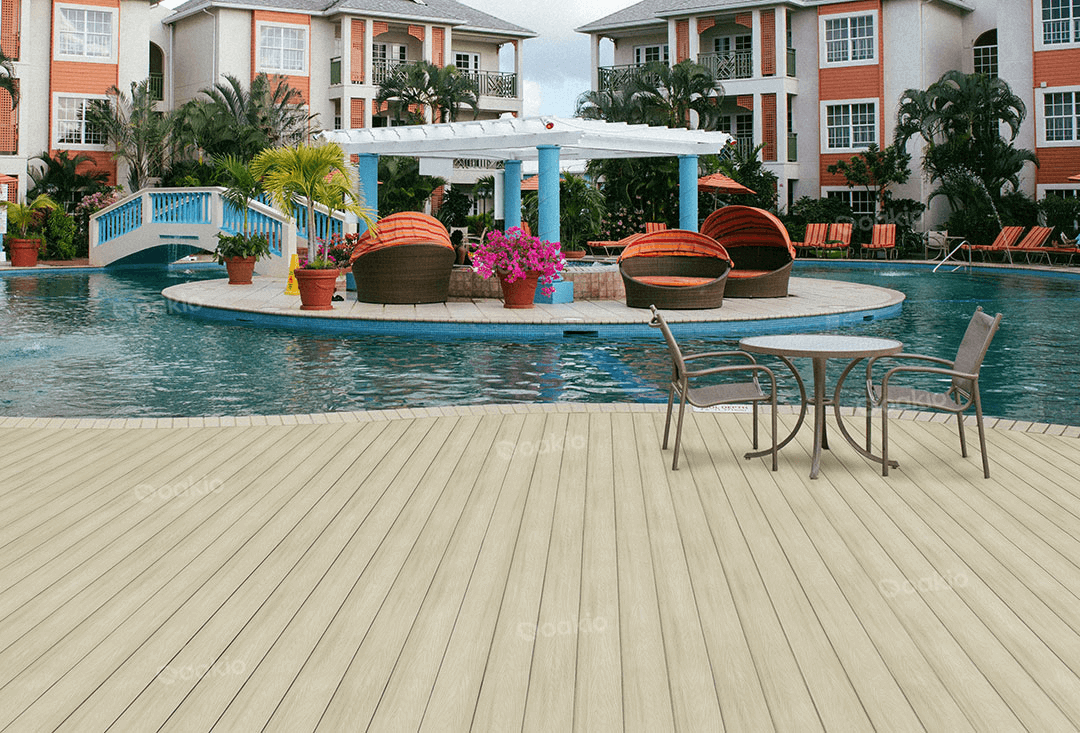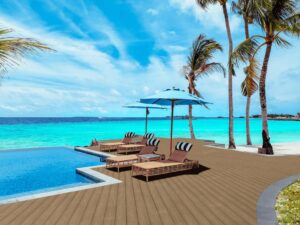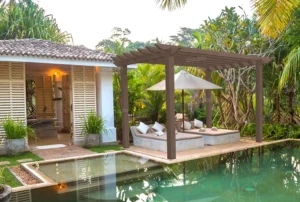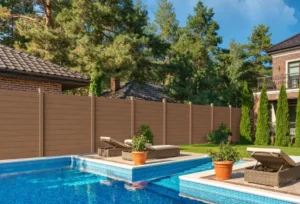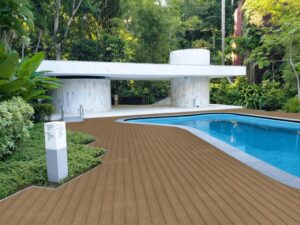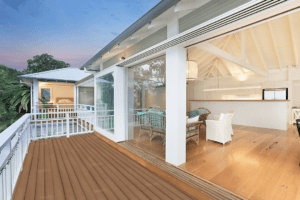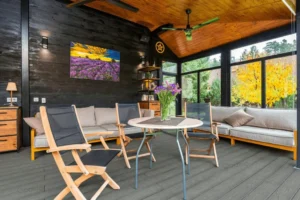Advantages of Wood Plastic Composite Decking
Wood Plastic Composite (WPC) decking has become a popular alternative to traditional wood decking and PVC decking in recent years. Many homeowners will choose WPC decking when designing their house. What is wood plastic composite decking? What are the advantages of WPC decking compared to timber decking and PVC decking? In this article, we will delve into these questions and help you make informed choice.
Understanding Wood Plastic Composite Decking
WPC decking is a composite material that combines wood fibers or flour with plastic polymers. The result is a versatile and durable decking material that mimics the appearance of natural wood while offering enhanced performance and longevity. The manufacturing process involves extruding the composite material into boards, which can then be shaped and finished like traditional wood decking.
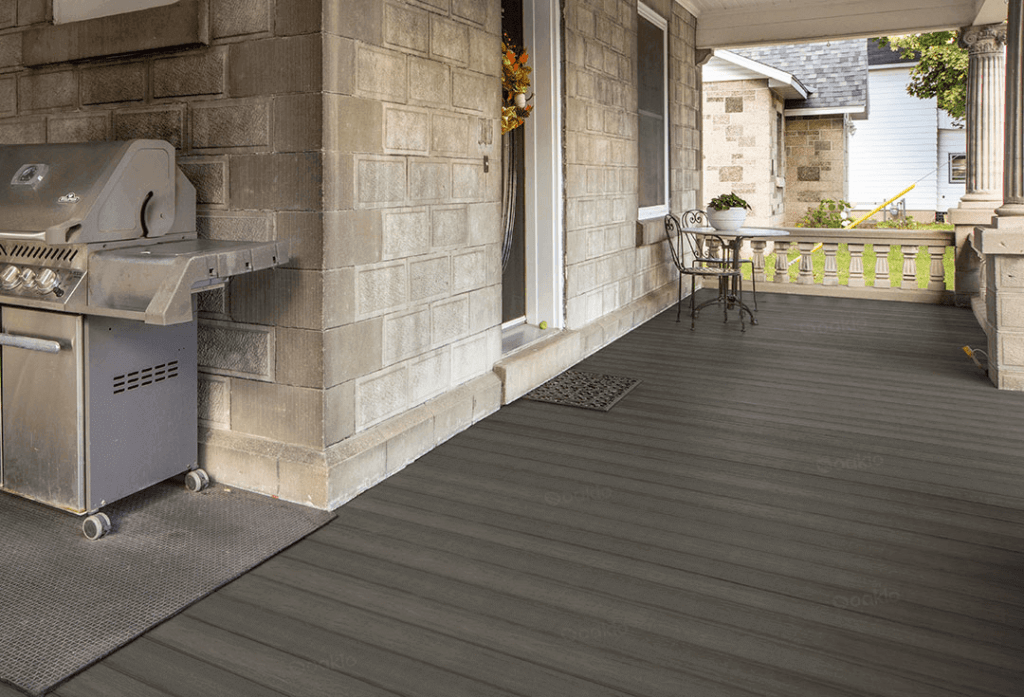
Advantages of Wood Plastic Composite Decking
Thanks to its composition and manufacture technique, WPC decking has several unique advantages compared with traditional wood deck.
- Longevity and Resistance to Damage: WPC decking offers exceptional durability, effectively withstanding rot, decay, and damage from insects. This makes it perfectly suited for outdoor use, especially in environments exposed to the natural elements. WPC boards maintain their integrity over time without splintering or cracking, which is a common issue with traditional wood decking. This results in a longer service life and lower maintenance needs.
- Minimal Upkeep: A significant benefit of WPC decking is the minimal effort required to maintain it. Unlike traditional wood decking that necessitates frequent treatments such as staining, sealing, and painting to preserve both its look and structural strength, WPC decking needs only a simple soap and water cleaning on occasion to maintain its appearance.
- Moisture and Mold Resistance: The inherent resistance of WPC decking to moisture, mold, and mildew positions it as an optimal selection for locations prone to high humidity or regular water contact. The synergistic effect of wood fibers and plastic polymers in WPC decking creates a moisture-resistant barrier, mitigating the potential for mold development and material decay.
- Eco-Friendly Choice: The production of WPC decking often incorporates recycled materials, offering a sustainable option for eco-minded consumers. Utilizing recycled wood fibers and plastic polymers not only lessens the reliance on virgin resources but also contributes to waste reduction in landfills, enhancing its eco-friendliness.
- Design Flexibility: The broad assortment of available colors, finishes, and textures makes WPC decking a versatile choice, enabling homeowners to tailor their outdoor areas to reflect their personal taste and style. Whether the preference is for a natural wood appearance or a modern look, WPC decking provides a variety of options to fulfill any design preference.
Comparison Between WPC Decking and Timber Decking
Timber decking, made from natural wood, carries a classic and timeless appeal. Timber decking options include a variety of wood species, each with its unique grain patterns and hues. Timber decking is always a popular choice for its aesthetics and nature when homeowner hope to create a cozy space. But it also has drawbacks especially in outdoor space.
Here is a list that compare the characteristics between timber decking and wood plastic composite decking, which can help you make decision if you want to replace wood deck with composite decking.
| Characteristics | WPC Decking | Timber Decking |
| Deformation | Not easy to deform | Easy to deform |
| Durability | Can last 15-25 years | Can last around 10 years |
| Environmental Friendliness | Made from recycled material | Made from wood |
| Painting/Polishing | Don’t need painting/polishing | Need painting/polishing |
| UV Stability | UV resistant | Low UV resistance |
| Outdoor Adaptability | Good for outdoor space | Not suitable for outdoor use |
| Moisture Resistance | Moisture resistant | Low moisture resistance |
| Mold resistance | Mold resistant | Low mold resistance |
Comparison Between WPC Decking and PVC
PVC decking, made from polyvinyl chloride, offers a durable and low-maintenance alternative to traditional wood decking. Its synthetic composition makes it resistant to moisture, mold, and insects, ideal for outdoor applications in various climates. PVC decking is known for its long lifespan and color retention, requiring minimal upkeep compared to wood. Its versatility allows for a wide range of design options, including various colors, textures, and finishes. With excellent durability and aesthetic appeal, PVC decking is a popular choice for homeowners seeking a hassle-free outdoor decking solution that withstands the test of time.
While PVC decking shares some similarities with WPC decking, including low maintenance requirements and resistance to moisture, it often lacks the natural aesthetic of wood.
| Characteristics | WPC Decking | PVC Decking |
| Deformation | Not easy to deform | Not easy to deform |
| Durability | Can last 15-25 years | Can last 15-25 years |
| Environmental Friendliness | Made from recycled material | Made from plastic |
| Painting/Polishing | Don’t need painting/polishing | Don’t need painting/polishing |
| UV Stability | UV resistant | UV resistant |
| Outdoor Adaptability | Good for outdoor space | Good for outdoor use |
| Aesthetic | Look like natural wood | Lack natural aesthetic of wood |
Conclusion
In conclusion, wood plastic composite decking offers a range of advantages that make it an attractive choice for outdoor applications. From its durability and low maintenance requirements to its resistance to moisture and mold, WPC decking provides homeowners with a sustainable and versatile decking solution. Compared to traditional wood decking and PVC decking, WPC decking offers superior performance and aesthetic appeal at a competitive price point. By understanding the advantages of WPC decking, homeowners can make an informed decision when selecting the right decking material for their outdoor space.
Trending Reading
What Are the Differences Between the WPC Board and PVC Board?
[2024 Update] How Long Does WPC Decking Last?
